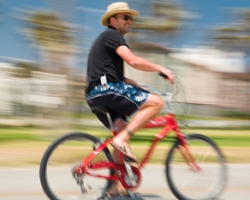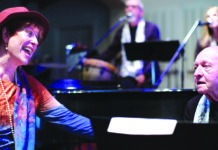Talk of bicycling is in the air these days and it’s not just the usual happy chatter of people riding in the mild sunshine as spring approaches and the days grow longer. Here in Culver City, in Los Angeles, in Southern California and around the country, people with a two-wheeled vision of urban life are beginning to alter the way their cities look. But it’s not easy – in some places, like New York, they’re even getting some pushback.
Culver City recently adopted a Bicycle and Pedestrian Master Plan after a months-long process with plenty of public participation. The plan establishes a rough blueprint for a number of projects that will make it easier, safer and both more practical and enjoyable to walk and ride throughout the city. Perhaps most importantly, simply having the plan in place now makes it possible for the city to seek grant money to convert some of those projects from vision into reality.
But we’re just beginning the process here. Already well-established is Long Beach’s pioneering program. The city adopted a bicycling master plan 10 years ago and now has a bike-share program for city employees, a bike station with 24/7 bike parking and daytime rentals, improvements to increase safe bicycling and walking to the Metro Blue Line Stations, hundreds of new bike racks to make parking more convenient, new road markings at intersections to prevent collisions between right-turning vehicles and bicyclists headed straight, and opening soon along Broadway and Third Street, Southern California’s only bike lanes physically separated from traffic (see details at bikelongbeach.org.)
Those won’t be the only such lanes for long. The city of Los Angeles has begun to take large steps toward adapting a city built for cars into something that accommodates and encourages bicycle riding.The Figueroa Corridor Project, with funding from Community Redevelopment Agency/Los Angeles, is holding public meetings to plan the creation of dedicated bicycle lanes in downtown Los Angeles.The next round of public workshops will take place in April. (Check out myfigueroa.com.)
As for the county, the release of the Draft Los Angeles County Bicycle Master Plan has just been announced. The plan proposes to more than quadruple the number of county bikeways within the next 20 years. Throughout Los Angeles County, new advocacy groups are forming to engage their cities in a process to move toward a more bicycle-oriented vision. Under the auspices of the Los Angeles Bicycle Coalition, regular meetings of such groups throughout the region – including the Culver City Bicycle Coalition – are facilitating the sharing of information and energy.
For trips between cities, bicycle advocates hope to make intermodal travel as seamless as possible, for instance, picture riding a new bike lane, or even a sharrow – a clearly marked lane shared by cars and bicycles (see photo) – through Culver City to the new Expo line station, and hopping on the train to downtown L.A.
It’s not just here in Southern California that bicycle-friendly change is taking off – it seems to have sparked the imagination of people across the country. In Chicago, the city’s Bike 2015 master plan anticipates increasing bicycle use so that 5% of all trips of less than five miles are by bicycle, reducing bicycle injuries by 50% and creating a 500-mile bikeway network that connects to within a half-mile of every Chicago resident.
Today, Chicago has more than 100 miles of on-street bike lanes and more than 155 miles of signed bike routes. Newly elected Mayor Rahm Emanuel has pledged to build 25 miles of new bike lanes each year.
In New York, Mayor Michael Bloomberg and his Transportation Commissioner have been greatly increasing the number of bicycle lanes throughout the five boroughs, resulting in a dramatic but unsurprising decrease in traffic deaths. But the New York program has been in the news lately due to a lawsuit brought by those who are upset at the loss of parking spaces and driving lanes, and the perceived danger to pedestrians posed by speeding cyclists. One leading contender for the next mayoral race has even pledged to tear out the bike lanes in his first year in office.
There’s bound to be some resistance to any change in how our communities function. Let’s hope that in an era of unparalleled – and worsening – traffic congestion, with all the costs, both hidden and obvious, attendant on automobile-centric transportation, we can make a thriving, vibrant and safe space for human beings who would like to be able to get around town on their own power – on two wheels.
Bike Safe, Bike Smart! is a weekly column to promote responsible cycling by providing information, education, and advice about riding. It’s written by members of the Culver City Bicycle Coalition (CCBC), a local chapter of the Los Angeles County Bicycle Coalition. Join them for their family bike ride, the last Sunday of every month. For more information and to submit your questions, write: ccbicyclecoalition@gmail.com, and visit their blog: culvercitybc.wordpress.com/.













